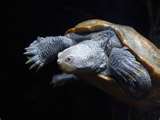|
|
African Sideneck Turtle: Aquatic Turtles from
Senegal, Africa
The African Side-necked Turtle is scientifically named
Pelomedusa subrufa. Besides African Side-necked Turtle, it
is also called the African Helmeted Marsh Terrapin, Marsh
Terrapin, Helmeted Turtle, or African Aquatic Sideneck
Turtle.
There are about fifteen different species of African Side-
necked Turtles, ranging in size at maturity from five inches
to well over eighteen inches long, but the most common so
far in the pet trade is the Pelomedusa subrufa, which is a
relatively small five or so inches long as an adult.
These aquatic turtles found in the swampy, soft-bottoms
waters of Senegal, Africa somewhat resemble the
Sliders and
Painted Turtles of North America, with a brown or black
carapace, black or yellow plastron, gray to black skin, and
an upturned "smile" and pug nose.
These turtles got their common name of "Helmeted" because of
the smooth, slightly domed shell with prominent schutes
which looks somewhat like a helmet. The name "Side-necked"
is given to a number of species of turtles through the world
because when they pull into the shell, they bend the neck
sideways to better hide their heads.
African Helmeted Turtle

The African Side-necked Turtle spends most of its life near
or in the water, so your turtle will need an aquarium of at
least 40 gallons of filtered and regularly changed,
chlorine-free water, with a large swimming area and a small
land area with smooth access. Plants on the land area are
not necessary unless you plan to breed them.
These turtles are from hot, humid regions, and need
temperatures between 70 (night) and 85 (day) degrees
Fahrenheit and high humidity. When they are not in the water
they are basking, and their basking area should be kept at
100 degrees F. Like most turtles they will also need a full-
spectrum UVB light for ten to twelve hours a day in order to
maintain bone and shell health.
Helmeted Turtles are omnivores, and will eat live feeder
fish, earthworms, mealworms, crickets, waxworms, bloodworms,
snails, turtle pellets, aquatic plants, fresh edible greens
such as kale or collards, and chopped carrots or squash. A
separate feeding tank is always recommended to help keep the
primary tank clean, and a good reptile calcium and vitamin
D3 supplement should be given occasionally to indoor pets.
The subrufa, most commonly called the Helmeted Turtle, is a
long-lived, prolific-breeding, hardy turtle that makes an
excellent pet. Be advised that if very frightened, these
turtles can give off an extremely noxious musk odor, but
this seldom happens in captivity. Although they are shy and
cautious like other turtles at first, your Helmeted Turtle
will, with care and time, become a curious and outgoing
character who may live with you as long as fifty years.
|